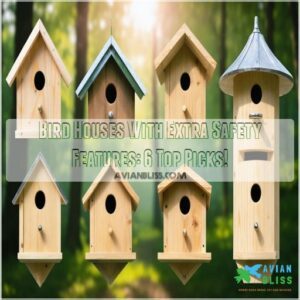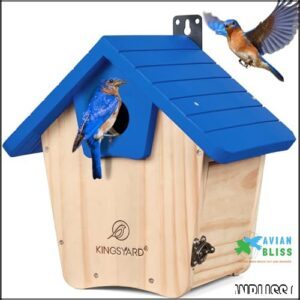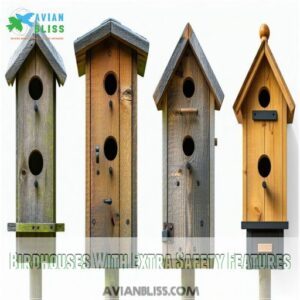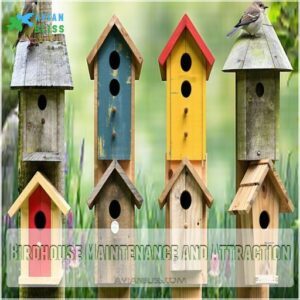This site is supported by our readers. We may earn a commission, at no cost to you, if you purchase through links.
 When choosing bird houses with extra features for safety, focus on options that prioritize predator protection and durability.
When choosing bird houses with extra features for safety, focus on options that prioritize predator protection and durability.
Look for models with precisely sized entrance holes suited to specific birds, like 1-1/2 inches for bluebirds, to keep larger predators out.
Features like metal hole guards, sturdy stovepipe baffles, and sloped roofs with extended overhangs keep raccoons, squirrels, and rain at bay.
Opt for untreated wood such as cedar or pine for breathability, and choose designs with ventilation holes and removable floors for easy cleaning.
Mounting the birdhouse 5-7 feet high on poles, away from trees, provides added safety. Keep exploring!
Table Of Contents
- Key Takeaways
- Birdhouses With Extra Safety Features
- Importance of Material and Design
- Top 6 Birdhouses With Extra Safety Features
- Birdhouse Maintenance and Attraction
- Expert Insights and Safety Considerations
- Frequently Asked Questions (FAQs)
- What are predator guards for bird houses?
- What kind of birdhouses will birds actually use?
- How to make a safe birdhouse?
- Where not to put a bird house?
- How do weather conditions affect birdhouse safety?
- What plants increase natural birdhouse security?
- Can outdoor lighting deter birdhouse predators?
- How to safely handle unwanted birdhouse occupants?
- Are there seasonal adjustments for predator protection?
- Conclusion
Key Takeaways
- Pick birdhouses with predator guards like stovepipe baffles and metal hole reducers to keep raccoons and squirrels out.
- Use untreated wood like cedar or pine and ensure proper ventilation holes, sloped roofs, and accessible cleaning designs.
- Match entrance hole sizes to specific bird species, like 1.5" for bluebirds, to block larger unwanted intruders.
- Mount birdhouses 5-7 feet high on poles away from trees, and add baffles for extra predator protection.
- Proper placement and construction are key for attracting birds while deterring predators.
Birdhouses With Extra Safety Features
If you’re serious about protecting your backyard birds from predators, you’ll want to invest in birdhouses with extra safety features.
These specialized designs include predator guards, strategically sized entrance holes, and thoughtful mounting techniques.
These features will help keep your feathered friends safe and secure.
Predator Guards for Birdhouses
The silent threat of predators can turn a promising bird sanctuary into a danger zone.
Protect your feathered friends with strategic predator guards that stop raccoons, snakes, and squirrels in their tracks.
Stovepipe baffles and metal hole guards are your best defense, creating an impenetrable barrier that keeps unwanted visitors from turning your birdhouse into a buffet.
Entrance Hole Size for Specific Birds
Why do different bird species need specific entrance hole sizes? Your birdhouse’s hole diameter can make or break nesting success.
Wrens thrive with 1-1/8" openings, while bluebirds prefer 1-1/2" holes. Chickadees squeeze through 1-1/4" entries, and purple martins need 2-1/2" diameter holes.
Matching hole size to bird species provides the best protection and prevents unwanted guests from invading.
Proper bird-friendly landscaping can also complement these birdhouse features, including the use of sunflower seeds and other bird attractants.
Sloped Roofs and Ventilation
After nailing the perfect entrance hole, smart bird lovers focus on roof design and air circulation. Sloped roofs aren’t just pretty – they’re survival gear for feathered friends.
- 2-4 inch roof overhangs shield nests from rain
- Drainage cuts prevent water pooling
- Ventilation holes regulate internal temperature
- 3/4-inch wall gaps boost air circulation
- Roof angles naturally repel potential predators
Precise roof engineering means happier, healthier bird families.
Oklahoma State University recommends using an untreated natural wood for birdhouse construction to support the well-being of the birds.
Mounting and Placement Considerations
When mounting your birdhouse, aim for strategic placement that keeps feathered friends safe. Position the pole 4-5 feet high, away from trees and potential predator highways.
Make certain the entrance faces east to catch morning warmth while avoiding prevailing winds.
Install a sturdy predator baffle to block climbing threats, creating a fortress of feathery protection.
Consider using a safe birdhouse mount to further secure your birdhouse and prevent accidents.
Importance of Material and Design
When choosing a birdhouse, you’ll want to prioritize materials and design that offer maximum protection for your feathered friends.
Your selection should focus on durable, untreated wood.
Features like ventilation holes, sloped roofs, and easy-to-clean designs keep birds safe from predators and environmental threats.
Durable Materials for Birdhouses
Protecting your feathered friends starts with choosing the right materials for your birdhouse. Smart wood selection is crucial for your battle against the elements.
Here’s what makes a birdhouse tough as nails:
- Cedar wood: Nature’s rot-resistant superhero
- Untreated pine: Breathable and bird-friendly
- Weather-resistant finishes: Extend your birdhouse’s lifespan
Weatherproofing isn’t just about survival—it’s about creating a safe haven that’ll keep your winged residents chirping for seasons to come. Weatherproofing is key for a safe haven. Extending lifespan is important for birdhouse construction.
Proper Ventilation and Drainage Systems
Step up your birdhouse game by nailing proper ventilation and drainage systems.
You can even find pre-made ventilation kits to simplify the process.
Mesh floors and well-placed holes prevent moisture buildup, keeping your feathered friends’ home dry and mold-free.
Strategically designed roofs with small ventilation gaps promote air circulation, creating a safe, comfortable environment that shields birds from humidity-related health risks.
Easy-to-Clean Designs for Birdhouses
Any birder knows a clean birdhouse is a healthy birdhouse.
Look for models with easy access panels, removable floors, and hinged roofs that make seasonal maintenance a breeze.
Smooth interior surfaces and quick-wipe materials simplify birdhouse cleaning, helping you quickly inspect and refresh nesting spaces.
Incorporating ventilation and drainage is also essential for maintaining a clean and dry environment.
Smart design means less hassle and happier, healthier birds.
Top 6 Birdhouses With Extra Safety Features
You’re about to discover six exceptional birdhouses.
These carefully designed homes provide robust protection, ensuring your backyard birds can nest, breed, and thrive without worry.
They’ll keep your feathered friends safe from predators and environmental challenges.
1. Cedar Birdhouse Outdoor Clearance Sale

Cedar’s natural charm meets bird sanctuary design in this outdoor clearance birdhouse.
You’ll appreciate its sturdy 4.9 x 4.9 x 11.81-inch dimensions and lightweight 1.54-pound construction.
The slanted roof expertly channels water away, while the round window promotes good air circulation and subtle predator deterrence.
Crafted from natural, polished wood with anti-rust accessories, this birdhouse promises a safe nesting environment for bluebirds and wrens.
Though manufactured in China, its fine workmanship and classic aesthetic make it a budget-friendly backyard wildlife solution that provides the right conditions for the birds.
Best For: Bird lovers seeking an affordable, attractive, and easy-to-clean birdhouse for bluebirds, wrens, and other small birds.
- Classic design and sturdy construction.
- Easy to clean and maintain.
- Budget-friendly option for attracting birds to your yard.
- Requires assembly without provided instructions, potentially leading to wood splitting.
- May need additional sealant for weather protection.
- Bottom screen might require modification.
2. Smart Birdhouse Camera with AI

The NETVUE Birdfly Nest Smart Birdhouse Camera combines advanced AI with eco-friendly design, offering 1080P FHD video and solar power for sustainability.
It features bamboo material, adjustable entrance holes, and predator guards, ensuring safety for various bird species.
With smartphone connectivity and motion detection, you’ll never miss a nesting moment.
However, users have reported occasional connectivity issues and challenges pairing the device in dark mode settings. Proper placement before nesting season is essential for maximum bird attraction.
For those interested in more smart birdhouse camera options, birdhouse camera products can provide additional features and designs.
Best For: Bird enthusiasts seeking an easy-to-use, solar-powered smart camera with AI features to monitor nesting activity.
- Eco-friendly bamboo construction.
- AI-powered automatic nesting moment capture.
- Easy app setup for live viewing.
- Occasional connectivity issues and firmware update problems.
- Inconsistent customer service experiences.
- Camera may go offline after extended use.
3. Wooden Birdhouses For Birds Outside

Crafted from durable natural wood, the Wooden Birdhouses for Birds Outside combine functionality and charm.
With a 1.57-inch entrance hole and a small perch, they’re ideal for smaller birds. Its aesthetic makes it a delightful backyard addition.
Cleaning is a breeze thanks to the accessible door, while its weatherproof design guarantees resilience.
While lightweight and attractive, it’s best suited for small species as larger birds may find it cramped. Some users reported cracking after weeks, so consider careful placement. Cleaning is a breeze.
Best For: Smaller bird species seeking a charming and easy-to-clean home.
- Easy to clean and maintain.
- Attractive and durable design.
- Simple to hang and install.
- May be too small for larger birds.
- Some reports of wood cracking.
- Lightweight construction.
4. Cartman Blue Bird House Wooden Birdhouse

Perfect for safety-conscious bird lovers, the Cartman Blue Bird House combines handcrafted charm and practical features.
Its premium natural wood and vented area support airflow, creating a healthier nesting space.
While it’s sturdy and attractively designed, the 1/4-inch wood does raise durability concerns.
Removing the perch under the entrance hole can reduce predator risks, and adding screws strengthens its construction.
Though the mesh floor helps with moisture prevention, it may require padding to protect birds.
Ultimately, it’s a cute, customizable option.
Best For: Budget-conscious bird enthusiasts seeking an attractive, customizable birdhouse.
- Sturdy and well-crafted design.
- Attracts birds quickly.
- Cute and detailed appearance.
- Thin wood (durability concerns).
- Small entrance hole.
- Potential safety hazard from mesh floor and magnet.
5. Heavy Duty Bird Feeder Pole Kit

The Heavy Duty Bird Feeder Pole Kit is a powerhouse for enhancing birdhouse safety. Its rust-resistant metal design and five-prong base provide stability and longevity, even in unpredictable weather.
The adjustable height allows you to position your birdhouse or feeder exactly how you need it, keeping predators at bay.
Using predator-proof mounting options is key to deterring curious critters and securing your birdhouse investments.
The top and side mounting options add versatility. For windy areas, securing the pole might help, but overall, it’s an excellent tool for protecting your birdhouse investments.
Best For: Bird enthusiasts seeking a durable and adjustable pole kit for their bird feeders and houses, prioritizing stability and longevity.
- Heavy-duty construction ensures long-lasting use.
- Adjustable height offers versatile placement options.
- Easy assembly makes setup quick and convenient.
- May require additional anchoring in windy areas.
- Some slight swaying reported in high winds.
- No mention of specific weight capacity.
6. Kingsyard Bluebird House Bird Nesting Box

Combining durable New Zealand pine and a royal blue finish, the Kingsyard Bluebird House elevates both style and practicality.
Its 1.5-inch entrance hole welcomes bluebirds, chickadees, and wrens while keeping predators at bay with a robust guard.
Thoughtful features like ventilation holes, an accessible cleaning door, and a viewing panel make maintenance a breeze.
However, reviews note occasional roof paint chipping and loose viewing glass.
For a sturdy, bird-friendly choice, this birdhouse encourages nesting quickly, offering safety and ease for bird enthusiasts.
Best For: Bird enthusiasts seeking a durable, attractive, and easy-to-clean bluebird house.
- Durable New Zealand pine construction.
- Easy cleaning access and viewing panel.
- Attracts a variety of birds, including bluebirds, wrens, and chickadees.
- Potential for roof paint chipping and damage.
- Viewing glass may be loose or fall out.
- Some reports of damage during shipping.
Birdhouse Maintenance and Attraction
Maintaining birdhouses properly and attracting birds requires regular cleaning, predator protection, and thoughtful placement. Providing food, water, and native plants can create a welcoming habitat for nesting.
Regular Cleaning and Inspection
Keep your birdhouses welcoming with a solid cleaning schedule.
Regular birdhouse maintenance, like removing debris and old nests, prevents parasites and mold.
Inspect for damage, repair cracks, and check ventilation holes to guarantee birdhouse security.
Winterizing tips, such as sealing cracks, protect against weather.
Routine birdhouse cleaning and inspection help safeguard birdhouse security and keep the nests snug.
Providing Suitable Food and Shelter
Offering birds reliable food and water sources boosts habitat enrichment and encourages nesting in your birdhouses.
Use bird feeders stocked with seeds or mealworms and provide clean water in shallow dishes or birdbaths.
These additions increase safe nesting chances while complementing predator-proof bird houses.
Pair these efforts with well-placed nesting boxes featuring sturdy predator guards for maximum birdhouse protection and security.
Planting Native Plants for Bird Attraction
When attracting birds, native plants are game-changers. They provide natural shelter, insects for food, and berries birds love.
Use a plant selection guide to identify bird-friendly trees like oaks or maples alongside pollinator plants.
Focus on local habitat restoration to boost bird conservation.
Sourcing seeds from verified suppliers supports biodiversity and creates sustainable, bird-friendly landscaping that keeps species thriving.
Avoiding Predators and Competitors
Boost birdhouse security with predator deterrents like stovepipe baffles or Noel guards to keep raccoons, snakes, and squirrels away.
Mount birdhouses on poles 5-7 feet high and avoid trees for added safety.
Use predator-proof bird houses with tight-fitting entrances to block competitor species like starlings.
Cat-proof designs and feral cat prevention.
Expert Insights and Safety Considerations
You’ll make smarter choices for birdhouses when you understand expert tips like predator protection and safe placement.
Thoughtful designs and materials help birds thrive while aligning with their natural behaviors and nesting needs.
Predator Protection and Birdhouse Placement
To keep nests safe, focus on predator protection and proper birdhouse placement.
Install predator guards like stovepipe baffles and use metal hole reducers for added birdhouse security.
Mount on a sturdy pole, 5-7 feet high, away from trees and branches. A wobbling pole deters climbing animals.
Correct house location guarantees a high level of safety for bird houses, enhancing nest security.
Regular birdhouse maintenance, including cleaning after each nesting season, prevents parasites and maintains a welcoming environment.
Avoiding Harmful Materials and Designs
When picking safe birdhouses, steer clear of harmful chemicals or treated wood that can harm birds. Opt for untreated, durable wood like cedar.
Avoid metal or plastic, as they overheat easily.
Ecofriendly birdhouses painted with safe, non-toxic paints are ideal.
Stay mindful of poorly ventilated designs, which trap heat.
Predator-proof birdhouses prioritize both bird comfort and safety.
Considerations for Specific Bird Species
Each species has unique nesting needs, so choosing birdhouses wisely is key to success. Chickadees prefer dense habitats and a 1.25-inch entrance hole, while bluebirds favor open fields with 1.5-inch holes. Wrens thrive in compact, hidden spaces, while tree swallows enjoy houses near water.
- Match habitat preferences: Dense woods for chickadees, open spaces for bluebirds.
- Nest box sizes matter: Too small or large can harm.
- Entrance hole size: Essential for species-specific safety.
Frequently Asked Questions (FAQs)
What are predator guards for bird houses?
Predator guards act like security gadgets for birdhouses, shielding nests from raccoons, snakes, and squirrels.
Examples include stovepipe baffles, metal hole guards, and Noel guards that block climbing, gnawing, or invading predators effectively.
What kind of birdhouses will birds actually use?
Birds favor natural, untreated wood birdhouses with proper entry holes, ventilation, and no perches.
Place them 5-7 feet high in species-specific habitats.
Models like Nature’s Way Cedar or Bluebird Essentials work well for most.
How to make a safe birdhouse?
Choose untreated wood, avoid perches, and install predator guards like stovepipe baffles.
Position the house 5–7 feet high, away from trees, with ventilation holes and sloped roofs.
Inspect frequently to maintain cleanliness and safety.
Where not to put a bird house?
Plopping a birdhouse near busy sidewalks, under direct sun, or too close to trees is like handing predators an invitation.
Go for open, shaded spots far from heavy foot traffic and climbable surfaces.
How do weather conditions affect birdhouse safety?
Harsh weather can damage birdhouses, exposing birds to rain, wind, and extreme temperatures.
Use sloped roofs, drainage holes, and ventilation to keep interiors dry and safe.
Regularly inspect for leaks or cracks to prevent hazards. This will help keep your birdhouses safe from weather damage.
What plants increase natural birdhouse security?
Imagine nature’s armor growing around your birdhouse—plants like dense evergreens, thorny bushes like hawthorn, or native vines provide cover from predators.
Keep them nearby but not too close to avoid aiding climbing invaders.
Can outdoor lighting deter birdhouse predators?
Outdoor lighting can deter some night-active predators near birdhouses, like raccoons or cats.
but it mightn’t discourage all threats, such as snakes.
Use motion-activated lights sparingly to avoid disturbing the birds themselves.
How to safely handle unwanted birdhouse occupants?
Over 80% of invasive starlings use birdhouses improperly.
Safely handle them by removing nests, installing hole reducers, or using bird-specific guards.
Always check for legal protections before acting to confirm you’re not breaking wildlife laws.
Are there seasonal adjustments for predator protection?
Adjust predator guards seasonally.
Inspect and reinforce baffles in spring, add insulation to protect against winter drafts, and clear leaves around poles in fall.
Regular checks keep birdhouses safe and year-round threats at bay.
Conclusion
Why not give birds a safer home with well-designed bird houses with extra features for safety?
From predator guards to proper ventilation, these structures protect feathered friends while offering durability and comfort.
Choose sturdy materials like cedar with sloped roofs and consider placement to keep predators away.
Whether it’s attracting bluebirds or maintaining easy-to-clean designs, these safety-focused options guarantee a lasting impact.
Take steps today to create a secure and inviting space for neighborhood birds near you!







